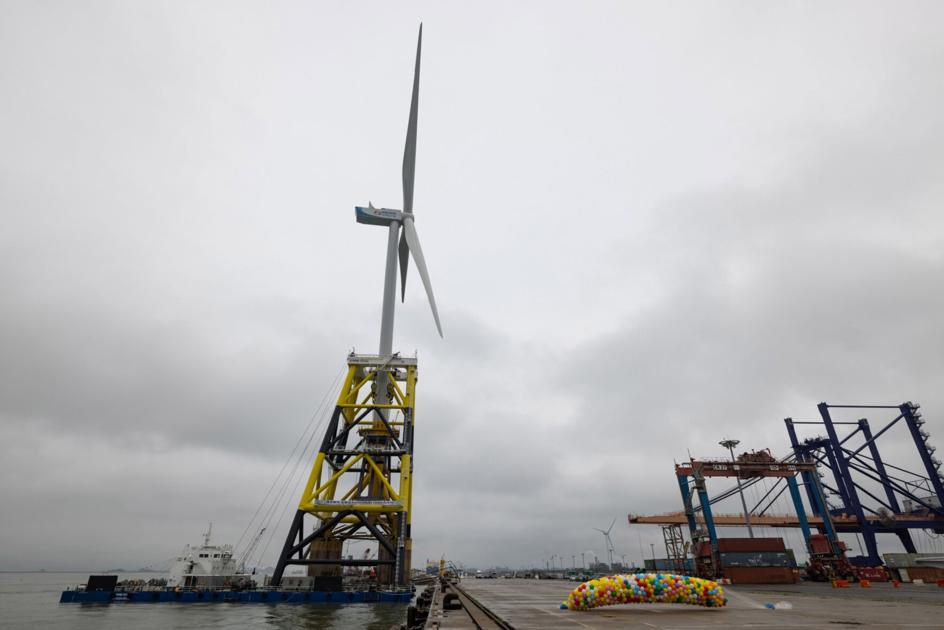Innovations accelerate the race to install more wind turbines at the bottom of the sea | Global affairs

[ad_1]
It’s getting faster and cheaper to fit a Washington Monument-sized wind tower into the seabed.
South Korea is reducing the time needed to build and install an offshore turbine from three months to just days, using a large flat-bottomed vessel for towing the structure and a “ditch” method. suction cup “for fixing it. The innovations could reduce the process by about $ 3 million.
The state-owned Korea Electric Power Corp. on Wednesday presented what it says is the first vessel capable of carrying a fully built wind power plant. A crane on the 1,500-ton ship, known as the Multipurpose Mobile Base, or MMB, lifted a 1,459-foot-high wind tower built in the water near the western port of Gunsan.
“Through the use of MMB technology, we should be able to achieve our goal of carbon neutrality by 2050 and make a huge contribution to wind power, which is the central element of the country’s transition. Kepco CEO Cheong Seung-il said at the event.
Innovations aimed at reducing costs and installation times promise to spur a global expansion of offshore wind energy which is already expected to increase capacity 11 times by 2035, according to BloombergNEF. Annual installations are expected to reach a record 11 gigawatts this year and reach 32.5 gigawatts by the end of the decade, as countries add more renewable energy to phase out fossil fuels and reduce carbon emissions.
China, which will account for nearly three-quarters of installations this year, and emerging markets in Asia, including Japan, Taiwan and Vietnam, will support these growth prospects, BNEF said in a report last month.
The sea offers one of the best prospects for green energy in South Korea, where the climate and topography are ill-suited for large onshore solar and wind power plants, and where conventional hydropower resources are almost fully utilized. The country is looking to add 12 gigawatts of offshore wind by 2030, compared to less than 0.2 gigawatts currently.
South Korea already has the world’s largest tidal power station at Lake Sihwa and is adding the world’s largest offshore wind farm near Shinan.
Kepco is reducing the 90 day period it can take under certain circumstances to build and install an offshore wind turbine. The company can set up a factory on land in seven days, and the MMB will then ship it to the offshore site. Transporting the entire plant significantly reduces the time and cost of having to make multiple trips to deliver parts.
The new process would reduce the cost of installing a 5-megawatt turbine by 43 percent, or 3.7 billion won ($ 3.3 million), according to a statement from Kepco.
The company is looking to increase the size of MMBs to transport up to 14 megawatts of turbines that are being deployed in Europe, according to Ryu Moo Sung, senior researcher at the Kepco Research Institute. He said German RWE and Spanish Ocean Winds have shown interest in Kepco’s ships.
Once the MMB is at the offshore site, it takes up to 12 hours to secure the tower to the ocean floor using a “bucket-suction†technique. The method pumps water from the buckets, creating pressure to force them into the ground. The southwest coast of South Korea is ideal for this technique due to the soft seabed.
The new process is an improvement over traditional methods, which can create environmental problems as cement is injected into the seabed to build a foundation, Kepco said. Additionally, offshore construction is vulnerable to delays caused by inclement weather, which can further increase costs.
The time it takes to install an offshore turbine has been steadily decreasing, with a rate twice as fast as 10 years ago, according to a BNEF report in 2019. In the United States, the Department of Energy and partners including the University of Delaware worked on accelerating construction of offshore wind farms using suction bucket technology.
[ad_2]
